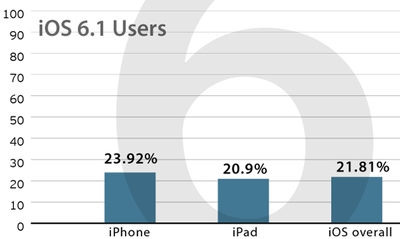Earlier this week, TechCrunch shared data from touch-based website developer Onswipe showing that, based on its user base of over 13 million monthly active users, over 21% of iPhone and iPad users had updated to iOS 6.1 in the first two days of availability.

We've since followed up with Onswipe to see how the share of users on iOS 6.1 has moved over the past several days, and the firm tells us that it is now seeing over 26% of users running iOS 6.1 just four days after its debut.
Onswipe CEO Jason Baptiste noted earlier this week that the rapid rate of adoption for iOS 6.1, which appears to be the fastest in history for Apple, is likely due to user comfort with the company's over-the-air updates, introduced with iOS 5 in October 2011.
The rapid uptake of iOS updates contrasts strongly with Android devices, where mobile networks are responsible for updates and just 10% of users are on the latest Jelly Bean versions, first introduced last July. The majority of Android users are still using Gingerbread, which dates to December 2010, or earlier versions of the operating system.
























Top Rated Comments
Thank God Apple had the foresight to tell the carriers that they would not have anything to do with OS updates to Apple devices. I think Samsung, HTC, LG, and Motorola (Google) would have a lot more satisfied customers if they'd followed Apple's lead and told the carriers to go eff themselves with respect to OS updates.
Doesn't the artical say they anyway?
You must have a lot of friends!
And web development for Android is a mess. Not only is there weak support for modern Android OS versions and huge variances in hardware performance but there are multiple different browsers in use as well. All with varying levels of support for the latest HTML, CSS, and javascript features. The result is that we have to design for the lowest common denominator.
Yep, that's right. It really doesn't matter if you're running a top of the line Android device with Jelly Bean. For most apps and sites you'll run into, your device is only using the same old APIs and features of a cheap old phone running Gingerbread.
This is the real downside of Android fragmentation for even the tech savviest of Android users who alway have the latest gear. They arguably suffer from Android fragmentation more than anyone because they pay top dollar for a device and barely ever get to use its capabilities in the apps it runs.
Meanwhile, even my tech illiterate mother in law is running iOS6.1 right now on her iPhone. She asked me if she update back in 5.x something but ever since then she does it completely on her own as soon as she is notified an update is available. And she gets to experience the best developers have to offer because they actually target her 2 year old iPhone with modern APIs and web standards that come with iOS6 because millions of other iOS users just like her update quickly as well.
Meanwhile her Dell computer is still running Windows XP SP2 with a bunch of updates for Windows, Office , Flash, and Java still not applied and her Xoom tablet is still running Android honeycomb collecting dust on a shelf. To her and millions of other regular people, upgrading software is often either scary (Windows) or not even a choice (Android).
iOS5+ is probably the most seamless OS upgrade experience consumers have ever had available and this is great for Apple, iOS developers, and iOS users.